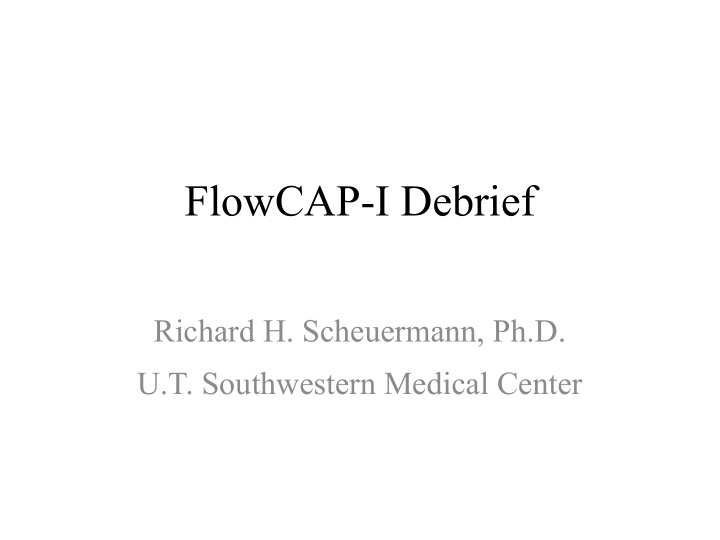



FlowCAP-I Debrief Richard H. Scheuermann, Ph.D. U.T. Southwestern Medical Center
FlowCAP-I is a success! Participation in FlowCAP-I was better than expected 1st generation algorithms before better than expected Interest in the stakeholder community was better than expected Comparison against manual gating good choice for FlowCAP-I; but perhaps more selective for FlowCAP-II
Other positives Easy to participate Excellent responsiveness Critical components “standard” datasets objective evaluation criteria
Challenge Maintain the momentum Learn from the experience Get the word out Ongoing support Rapidly attain the goal of making computational algorithms an essential component of standard FCM data analysis
Room for improvement Manual gating as “gold standard” Handling of “outliers” Evaluation metric Dataset use case coverage 4 challenges Sufficient time Sufficient information Others
The elephant in the room - Should manual gating be the gold standard?
Why weren’t WNV and ND included in Challenge 3? We knew that we didn’t have a good estimate of “k”
Manual gating Exhaustive gating vs. selective gating Discovery (clustering) vs. classification Need both Manual gating needs to be done carefully by explicitly guiding the gaiter
Were outliers handled properly? Every cell that was not included in the manual analysis by the human expert (due to noise or lack of biological interest) will be considered as an outlier for the purpose of this challenge. Algorithms will not be penalized for assigning an incorrect label to cells that are marked as outliers by these criteria. However, predicting biologically relevant (i.e., non-outlier) cells as outliers (with not assigning that cell to a cluster) will penalize the algorithm. Therefore, our advice is that the algorithms should analyze all
Outliers Outliers/noise should not be excluded from the analysis if “k” is given, unless they are filtered from the dataset One “k” for outliers may not be sufficient if included
Objective evaluation metrics Is F-measure a sufficient metric? Is time relevant?
Did we have sufficient datasets? 5 datasets 115 samples total Maximum # of events = 100,000 Maximum # of markers = 10 + 2 (only 17,000 events)
Datasets did not represent the scope of the problem well Relatively small number of events Not enough high dimensional data Cross sample comparison not included Rare population use case not explicitly represented
Requested datasets Scientific use cases Detection of rare cell populations (e.g., minimal residual disease in cancer); Enumeration of large numbers of distinct cell populations in high dimensional flow cytometry data (e.g., >10 colors); Discovery of clinically relevant cell populations in patient cohorts associated with disease states (e.g. markers of autoimmune disease, survival indicators in lymphoma); Measurement of DNA quantities (e.g., Flow-FISH);
Did we need 4 different challenges? Completely automated Tuned algorithm Population number Trained algorithm (supervised classification)
Was there sufficient time for each challenge? 3 months for Challenge 1 and 2 3 weeks for Challenge 3 3 weeks for Challenge 4
Were the dataset descriptions sufficient for biological “Data sets should also be accompanied by interpretation? metadata descriptions about the specimens and staining procedures used compliant with the MIFlowCyt data standard” Difficult to arrive at any biological interpretation
Data formating issue Need for better standardization of available file formats
Is the competition agreement reasonable? Publishing the datasets provided by flowCAP is prohibited until the project publishes the results. The datasets and results of the flowCAP project will be publicly available for any use after the summit. Software submitted to flowCAP will remain confidential. Participant won’t be identified (by name, group name, etc) in any materials without their approval.
Recommend
More recommend